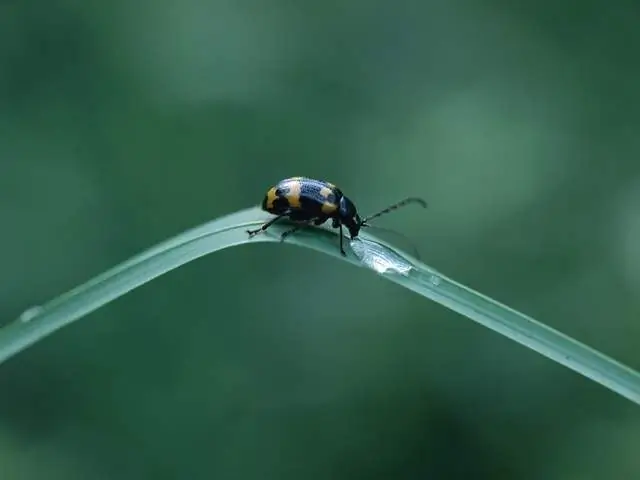The harmony of nature is guessed in its smallest, at first glance imperceptible manifestations. You can make perfection more noticeable in the drawing. Even the image of a small beetle on a blade of grass will become the embodiment of perfect natural beauty.

It is necessary
- - paper;
- - a simple pencil;
- - eraser;
- - watercolor;
- - brushes;
- - palette.
Instructions
Step 1
Take a sheet of watercolor paper. Since the object in the picture is small, A5 format will suffice. Place the sheet horizontally.
Step 2
Make a pencil sketch. First you need to determine the composition of the drawing. Divide the paper space in half with vertical and horizontal lines. There will be a beetle at the point of intersection of the axes. Its length is about one-sixth of the entire length of the horizontal axis. The height of the beetle is about half its length.
Step 3
Take a third of the entire length of the beetle to its head and "neck". Divide this area in half vertically. Draw the paws of the insect. Their length in an extended state is equal to the height of the body. The front and middle legs are bent, so they look somewhat shorter.
Step 4
Mark the outlines of the spots on the beetle's shell. Try to repeat their shape as accurately as possible so that the shape of the insect's entire body is not visually distorted. Do not draw a drop of water with a pencil, it is better to apply it immediately with watercolors.
Step 5
Use a nag eraser to lighten the lines of the sketch so that they are not visible through the layer of paint.
Step 6
Choose squirrel wool brushes for coloring. First, paint the blade of grass on which the beetle sits. Fill it (except for the area on which the drop of water lies) with a mixture of green and blue - mix them on the palette, achieving a cold shade of aqua. In the foreground, lighten the edge of the leaf by removing the excess paint with a clean wet brush. The back of the sheet needs to be darkened. Add more base color and a small amount of ocher.
Step 7
Draw a drop on the piece of paper. Leave the most illuminated part of it unpainted, white. Then mix a light blue color in the palette and apply it with a thin brush, imitating the veins of the leaf inside the drop. Around it, depict a shadow with the main color of the blade of grass, which becomes darker and darker closer to the drop.
Step 8
Fill the spotted beetle shell with color. At the same time, make its side darker than the back, which is illuminated. Add blue to the black spots in the illuminated area. Draw a shadow under the beetle and at each of its paws. With a thin brush or watercolor pencil, draw the lines of the insect's whiskers. Lastly, color in the background of the picture.






